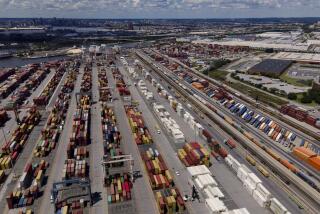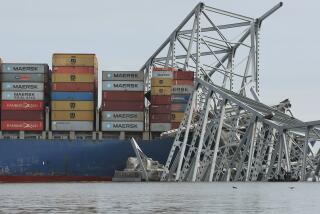Cargo traffic slows at L.A., Long Beach ports
The strains of Japan’s disasters are showing up at the local ports, with cargo traffic slowing through the Los Angeles and Long Beach harbors.
The number of cargo containers moving through the nation’s two largest ports in March dipped by an almost imperceptible amount — 217 containers — compared with February. The ports registered an improvement of about 4% from March 2010, moving 1.01 million containers compared with 973,024.
“The earthquake and tsunami in Japan have started to affect the flow of goods,” said Paul Bingham, economics practice leader with Wilbur Smith Associates. “That probably reduced overall trade at the Southern California ports by at least a couple of percentage points.”
Imports through Los Angeles rose 10.2% in March to 297,023 containers, compared with 269,634 a year earlier; exports climbed 19.2% to 192,849 boxes. But the number of empty containers being shipped overseas, where factories refill them for return to the U.S., fell 6.6% to 110,924. Overall traffic for March rose 9.2% to 600,796 containers.
“We had 10% growth for the first quarter, which was stronger than we anticipated,” said L.A. port spokesman Phillip Sanfield. “Exports were particularly strong. We have been pushing hard on our international trade program to reach out to exporters around the region, helping them learn to navigate the export business.”
In Long Beach, a string of 15 consecutive months of year-over-year increases ended as imports fell 7.5% to 191,211 containers from 206,652 a year earlier. Exports grew 1% to 131,761 containers. Overall traffic, including empties, declined 2.5% to 412,235 containers.
Long Beach’s cargo numbers also reflected the loss of tenant California United Terminals, which moved to the L.A. port.
Imports to California from Japan last year totaled $40.7 billion, with nearly 80% arriving by ship, said Jock O’Connell, international trade advisor to Beacon Economics. Top Japanese imports were vehicles and their parts, high-tech machinery and consumer electronics, he said.
Both ports are focusing on looming threats to their market share, particularly the Panama Canal. An expansion of the canal, expected to be completed in three years, will allow much larger ships to pass through and potentially divert some cargo that would normally pass through Los Angeles or Long Beach.
On Monday at the L.A. port, China Shipping Co. will unveil a terminal expansion that will allow it to load and unload two ships at once rather than just one. Later in the day, more than 100 of China Shipping’s cargo customers have been invited to a networking symposium where city officials are hoping to learn more about their business needs.
“Anything we can do to assist these businesses will help the level of employment and job growth we have at the port,” First Deputy Mayor Austin Beutner said.
Long Beach officials said work will begin in the coming weeks on its Middle Harbor project, a $1-billion effort to double the amount of cargo handled by two existing terminals while halving the pollution they produce.
“We’re all battling over where the nation’s trade is going to go over the next decade,” said Art Wong, spokesman for the Port of Long Beach. “If we expect our customers to make long-term commitments to us, we have to show them that we are doing our part.”







